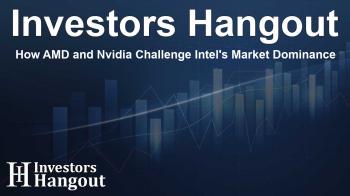How AMD and Nvidia Challenge Intel's Market Dominance

The Rise of AMD and Nvidia Against Intel
In today’s fast-evolving tech landscape, the rivalry between industry giants is palpable. Intel Corp’s crisis seems deeper than anticipated as competitors like Nvidia Corp and others are aggressively capturing Intel’s market share, crucial for its profitability.
Intel's Stock Struggles
Over the past year, Intel’s stock saw a staggering drop of 58% as it struggled to keep pace with the rapid growth of new computing applications and chip innovations. Analysts highlight that this failure has allowed rivals like Nvidia to seize opportunities.
AMD's Revenue Surge
Advanced Micro Devices, Inc (NASDAQ: AMD) recently eclipsed Intel’s data center chip revenue, marking a significant shift from previous years when Intel dominated the sector. This highlights AMD's resilience and strategic maneuvering in a competitive market.
The Impact of AI on Semiconductor Design
Nvidia's rise to a trillion-dollar valuation illustrates the importance of the graphics processing unit (GPU) market, an area Intel has overlooked. As the demand for artificial intelligence (AI) technologies expands, the focus has shifted toward innovation in GPU solutions.
Companies Moving Away from Intel
Prominent firms like Amazon.Com Inc, Microsoft, and Alphabet Inc (including both Google and its parent company) are increasingly investing in new data center infrastructures while circumventing Intel’s proprietary x86 chips. Instead, they are implementing a hybrid approach, leveraging ARM architectures alongside custom chip designs.
Intel's Response to Competition
Despite its setbacks, Intel still retains approximately 75% of the CPU market share in data centers. However, there is a glaring discrepancy between its market share and the revenue derived from data center chips.
The Perils of the PC Gaming Market
Intel's misstep in the PC gaming arena allowed AMD to capture significant market share. The importance of a robust product portfolio could not be overstated as Intel continues to emphasize enhancing its manufacturing capabilities and exploring new technologies.
Leadership Challenges Within Intel
Intel is navigating tumultuous waters as it looks for a new permanent CEO following the dismissal of its long-term chief executive. The previous attempts at a turnaround, particularly in competing with Taiwan Semiconductor Manufacturing Co (NYSE: TSM), have not yielded satisfactory results for the board.
An Ongoing Commitment to Technology
Despite challenges, analysts remain cautiously optimistic about Intel's potential. They highlight that the years of development surrounding Intel's software ecology still offer some protection, presenting opportunities to recover in the future.
Future Projections and Partnerships
Looking ahead, industry analysts predict Intel’s revenue for the upcoming year may hit around $55 billion, while Nvidia could potentially reach $60 billion. However, Intel still holds significant market positions in desktop and notebook CPUs, as reported by research firms.
Collaboration with AMD
In an unexpected development, Intel recently teamed up with AMD to enhance the x86 ecosystem, aiming to bolster its technology stack. This collaboration reflects Intel's understanding of its current market dynamics.
Innovative Projects on the Horizon
Intel is also pioneering new projects, including a chipmaking partnership with Amazon, leveraging its advanced 18A semiconductor technology. Additionally, Intel is gearing up for the launch of an innovative AI chip called Falcon Shores by 2025.
Investment Opportunities
Investors seeking to navigate these market dynamics can explore investment through options like Vanguard S&P 500 ETF (NYSE: VOO) and SPDR S&P 500 (NYSE: SPY), which provide exposure to Intel and its performance within the larger market.
Market Performance
In recent trading sessions, Intel's stock recorded a slight decline of 1.88%, valued at approximately $20.17, indicating the ongoing volatility of its market position amidst the fierce competition.
Frequently Asked Questions
Who are Intel's main competitors?
Intel's main competitors include AMD and Nvidia, as well as other tech giants like Microsoft and Amazon that are venturing into the semiconductor space.
What led to Intel's decline in stock value?
Intel's stock value has declined due to its inability to adapt to new market demands, particularly in AI and GPU technologies, which competitors have capitalized on.
Is Intel still a leader in any market segments?
Yes, despite recent challenges, Intel still leads in market share for desktop and notebook CPUs and retains a significant portion of the data center market.
What collaborations is Intel engaging in to improve its market standing?
Intel is collaborating with AMD to strengthen its x86 ecosystem and partnering with Amazon on advanced chip technology to enhance its competitive edge.
What upcoming innovations can we expect from Intel?
Intel is planning to launch a new AI chip called Falcon Shores by 2025, indicating its commitment to remaining relevant in a rapidly changing tech landscape.
About The Author
Contact Riley Hayes privately here. Or send an email with ATTN: Riley Hayes as the subject to contact@investorshangout.com.
About Investors Hangout
Investors Hangout is a leading online stock forum for financial discussion and learning, offering a wide range of free tools and resources. It draws in traders of all levels, who exchange market knowledge, investigate trading tactics, and keep an eye on industry developments in real time. Featuring financial articles, stock message boards, quotes, charts, company profiles, and live news updates. Through cooperative learning and a wealth of informational resources, it helps users from novices creating their first portfolios to experts honing their techniques. Join Investors Hangout today: https://investorshangout.com/
The content of this article is based on factual, publicly available information and does not represent legal, financial, or investment advice. Investors Hangout does not offer financial advice, and the author is not a licensed financial advisor. Consult a qualified advisor before making any financial or investment decisions based on this article. This article should not be considered advice to purchase, sell, or hold any securities or other investments. If any of the material provided here is inaccurate, please contact us for corrections.

